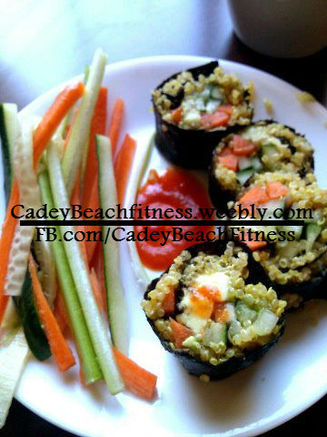 Simple Vegan Sushi . Did you know its super easy to make healthy sushi at home? If I can do it in a hotel you can do it at home!
Ingrediants-
1 small carrot
1/2 small cucumber
1 stalk celery
1/4 avocado
3-4 tbsp warm Quinoa
Directions slice first 3 ingredients into small long strips like in picture above. slice 1/4 avocado and spoon out, slice into thin slices and set aside. Lay one piece of Nori paper out on flat dry surface. Add warm quinoa ( NOTE: for me in order to roll the sushi the quinoa has to be warm to soft them paper to keep from breaking!) Now add your thinly sliced vegetables and add your avocado. Roll up your Nori roll. ( Click HERE for tutorial) Now slice up and ENJOY!
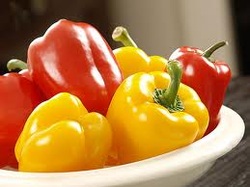 If you look at the bottoms of many bell peppers, you may notice that some of them have three lobes on their bottoms and others have four. Less common varieties of bell pepper may have one, two, or five lobes, but the ones available in North American grocery stores typically have three or four. Some culinary writers claim that this difference affects the pepper’s taste and the amount of seeds it has. However, these claims appear to be largely unfounded. The main difference is the number of lobes on the peppers’ bottoms, no more and no less.
According to the culinary blog GetYvonne.com, by Yvonne Deatherage, three bottomed bell peppers are “sweeter and better for eating,” while four bottomed bell peppers are “firmer and better for cooking.” A few other blogs and question/answer sites give the same information. However, many others disagree. Several commentors say they have never noticed any difference in taste or texture between three bottomed bell peppers and four bottomed bell peppers. Bell peppers do have different flavors if they are different varieties. However, whether they have three or four lobes on the bottom is not a determining factor in what variety they are. Certain varieties may tend more heavily toward four lobes or three, but both shapes of bell pepper may grow on the same plant. All three and four bottomed bell peppers belong to varieties that produce three or four lobes, or that produce two to five. A page on eHow gives a detailed description of another putative difference. Three bottomed bell peppers, it claims, are male, while four bottomed bell peppers are female. Female bell peppers have more seeds than males. For this reason, eHow advises always buying “male” bell peppers at the grocery store... since females have more seeds, they weigh more, and weigh more because of something you will only throw away, making them a "waste" of money. Unless you are one of the rare few who take the time to preserve these seeds! If there is any such thing as male and female bell peppers, the designation is culinary, not biological, and if it is a culinary designation, it does not appear to be a widespread one. Fruits (bell peppers are biologically fruits, being the seed bearing part of the plant) have no gender. They are not the plant’s sexual parts, but the vehicles for its offspring, formed only after the plant has been pollinated and fertilized. On most flowering plants, including bell peppers, the flowers that become the fruit have both male and female parts, making them androgynous. All bell peppers, then, are hermaphrodites. No Internet sources available at the time of this writing support or refute eHow’s claim that four bottomed bell peppers have more seeds. In my own experience, having cut up many a bell pepper, larger ones usually have more seeds. Since four bottomed bell peppers tend to be slightly bigger than three bottomed ones of the same variety, that claim may have some merit. However, if it does, it is due to the pepper’s size, not its number of bottom lobes, and the difference would be negligible when it comes to paying for the pepper by weight. The difference between three bottomed bell peppers and four bottomed bell peppers cannot be found in taste or texture. There may be slight differences in size and in the amount of seeds they produce, but these differences are negligible. The only real difference, which is so slight that many bell pepper eaters are unaware of it, is appearance.
 A veggie wrap for lunch. A night out for sushi. And you're working out . . . but you're still not losing weight. What gives? Some "diet" foods may be your worst enemy. That's because they're tricking you into eating too many calories. So what are some of the worst offenders? - Sushi: Fish wrapped in rice and seaweed. Not a diet food? Yep, that's right. It's not always as "light" as it seems. Some sushi has calorie levels so high it might just shock you.
Diet Shocker: One eight-piece serving of Philadelphia sushi roll is the caloric equivalent of 1 medium bagel with plain cream cheese—close to 500 calories. It's the cream cheese that gets you. And what about spicy tuna and other mayo-based rolls? They can contain as many as 450 calories and 11 grams of artery-clogging fat per serving. Eat too many of the "wrong" rolls and you're in Big Mac® calorie territory. - Wraps: You order the whole wheat veggie wrap thinking it'll put you on the skinny track. But is it actually the fat track? For some reason, wraps have been viewed as a healthy upgrade from a sandwich, but this isn't always the case.
Diet Shocker: The tortilla holding your wrap together can easily contain the same number of calories as four slices of bread, not to mention more carbs and twice as much fat. Many kinds of wraps you get at a deli have at least 300 calories. And that's just the tortilla, not the contents. You also have to factor in the fillings—and keep in mind that a wrap has more surface space to spread these calorie-boosting culprits:All told, one healthy-seeming wrap can easily trick you into eating hundreds more calories than you planned. - Granola: When you're having granola, you might think, "It's healthy. The fiber and all those little pieces of dried fruit are so good for me." Truth is, although it's got good stuff in it, it also packs in the calories.
Diet Shocker: A half-cup serving is what's often listed on the nutrition label of prepared granola. But who eats just half a cup? For most brands, there are more than 400 calories in a one-cup serving of granola. And when's the last time you actually measured? If you keep filling your cereal bowl with this stuff, it's no wonder you're not losing! - Bran Muffins: The kinds sold at many bakeries today aren't the little 3-inch muffins Grandma used to bake. They're much, much bigger. And just because they're made with "healthy" bran doesn't mean they're a diet food, either.
Diet Shocker: The average bakery muffin can contain as many as 630 calories. You might be slightly better off with a bran muffin than, say, a banana or blueberry one because of bran's extra fiber, but most of them are still packed with sugar and butter. Eat one bran muffin from Dunkin' Donuts® and you'll be consuming 480 calories, 13 grams of fat, and 46 grams of sugar. OMG. - Dried Fruit: The more fruit you eat the better, right? Not when it comes to the dried stuff.
Diet Shocker: You could boost your calorie count as much as four times (!) by choosing to eat the dried version of a fruit rather than its fresh counterpart. Check out these calorie comparisons based on a 100-gram (about 1 cup) serving:
- Pumpkin-Flavored Baked Goods: Pumpkin is nutritious, but these baked goods can be a dieting disaster. Like bran, pumpkin has lots of stuff that's good for you. So if you see pumpkin on a baked-goods label, it's easy to think you're eating something that's lower in calories. Not the case, though: Pumpkin doesn't mean diet food.
Diet Shocker: Dunkin' Donuts strikes again. Their pumpkin muffin has 630 calories and 28 grams of fat. OMG again! Want to switch bakeries? It won't help much. A pumpkin muffin from Panera Bread® has 530 calories and 20 grams of fat, and the pumpkin scone at Starbucks® has 470 calories and lots of fat too—22 grams' worth. You might as well be eating pie with whipped cream! - Olive Oil: It's a good fat and helps you burn fat. However, you don't need a lot of it to get the benefits. Two tablespoons a day can do the trick. And overdoing it can backfire.
Diet Shocker: Olive oil served with bread at a restaurant is heart-healthy, but high in calories. You can easily sop up a quarter of a cup. That's 478 calories, not including the bread. Or the rest of the meal you've ordered. - "Healthy" Salads: That's what some restaurants want you to believe in their "lite" section of the menu. It must be diet-friendly, right? Not always.
Diet Shocker: Listed under "Healthy Options" on the T.G.I. Friday's® menu, their pecan-crusted chicken salad, which contains mandarin oranges, dried cranberries, and celery, has 1,360 calories. Meanwhile, their cheeseburger and fries combo weighs in at 1,290 calories. Say it ain't so.
So what's a dieter to do in a world filled with "diet" traps? Ask about nutrition and read food labels. After a while, you'll be a pro at it and enjoy the weight loss that comes with it. You won't even have to give up the foods you like. That's because you'll know how to work them into your food plan the right way. By Justine Holberg
Are you thinking about going vegan but aren't sure you'll be able to get the results you want from your workout program? In this article, we tackle this question and the 9 others that are likely on your mind.
By going vegan, you're making a commitment to avoid all animal products and by-products. This means not eating meat, dairy, honey, and other products, and also not wearing leather, fur, and other products made from animals. Why do it? If done in a healthy way, it can be great for your body and for the planet. Recent research published in the journal Diabetologia revealed that reducing meat intake can help reduce your risk of type 2 diabetes, and a study from London's Imperial College shows it may be able to prevent long-term weight gain.
Converting to a vegan lifestyle isn't easy, but it's a lot easier than it was 20 years ago . . . even if you don't live in alternative-diet-friendly California. These days, you'll find vegan restaurants in most urban centers, and vegan books and online resources abound. And, to help you get many of the nutrients and some of the protein you need, Beachbody® recently introduced Chocolate Vegan and Tropical Strawberry Shakeology.
To help you make the switch, we asked Beachbody Wellness Expert Denis Faye the 10 questions we get most often. And, as a bonus, he even decided to answer them.
- I want to build muscle. Can I do this if I'm vegan? Yes. It can be a bit more challenging to eat enough healthy calories to build serious mass, but it can be done. And, believe it or not, vegan bodybuilders do exist. Case in point is the author of Vegan Bodybuilding & Fitness, Robert Cheeke. I'd hate to meet that guy in a dark alley and suggest he eat a pork chop.
- Will I be able to get enough calories as a vegan if I'm training with a program like P90X® or INSANITY®? Yes. Eating foods like tempeh, nuts, and legumes will help you reach your caloric needs no matter what program you're doing. In addition, the P90X2® nutrition guide has an entire vegan plan. Also, here's an article on going vegan P90X-style in the newsletter archives.
- What are the top foods I should add to my diet? I'm afraid I won't be getting enough calcium, vitamin B12, vitamin D, or iron. The fact that you know these are the micronutrients your diet may be short on puts you ahead of the game. Whole-grain cereals and breads are often fortified with these 4 micronutrients, but you can't live on grain alone. Here's a breakdown of what to keep in your kitchen.
- Calcium: Leafy greens, almonds, broccoli, oranges, chickpeas, soy. A salad a day should cover it.
- Iron: Spinach, sesame and pumpkin seeds, garbanzo, navy and lima beans, soy, and lentils. Add these to your salad, snack on the seeds alone, or make a hearty chili or stew.
- Vitamins B12 and D: For these micronutrients, vegetarian sources are hard to find, so you'll want to take a good multivitamin.
- Can I just substitute soy for meat in all my recipes? Technically, yes, but I wouldn't recommend it. Soy is a great tool for vegans in that it's one of the few "complete" vegetable proteins out there. It has the 9 essential amino acids you need to survive. It's also rich in the other micronutrients we discussed in the previous question.
That said, it's never healthy to overeat any food. And furthermore, soy-based fake meats tend to be packed with sodium and chemicals.
A serving of soy a day, preferably in fermented forms such as tempeh or miso, is fine. If you're worried about estrogen, don't be. The estrogen in soy is known as phytoestrogen, and these hormone-regulating compounds are different from those made by the human body. For the record, the only recorded case of someone developing man boobs from eating too much soy was a 70-year-old man who drank nearly a gallon of soy milk a day—and they went away when he stopped.
- Are there any supplements I should take? You should add a supplement that includes vitamins B12 and D to your diet. You may also be low on omega-3 fatty acids as these most commonly come from eating fish, so consider adding a vegan-friendly omega-3 supplement such as flaxseed oil.
- If a food product doesn't have dairy, honey, or meat listed as an ingredient, it's vegan, right? No! Animal products are everywhere. For example, gelatin, which you'll find in JELL-O®, puddings, marshmallows, and the casing for gel-caps, is made from animal bones. Many winemakers use albumin, dried blood powder, milk proteins, or fish bladders to remove sediment and other particles before the wine is bottled. And cane sugar is often whitened using charcoal from cow bones. But, hey, you shouldn't be eating sugar anyway.
The easiest way to avoid animal products is to eat as many whole foods as possible instead of "food products." And, when it comes to supplements, stick to those that plainly state that they are vegan, such as vegan Shakeology®.
An exhaustive list of foods that contain animal products is too long to include here, but PETA® maintains a complete guide.
- Is there any truth to combining proteins to make a complete protein? Absolutely. Dietary protein is made up of 20 amino acids. The human body produces 11 of those, leaving 9 that we need to get in our diet to survive. Animal-based foods are rich in these 9, making them "complete" protein sources. Individual vegetable sources tend to be missing one or two, so it's important to combine certain ones to get all 9. A classic example of this is the combination of legumes and grains (i.e., rice and beans).
But you don't need to eat all 9 at one meal as long as you get them during the course of the day. If you have sprouted whole-grain toast for breakfast and a three-bean salad for lunch, you're in good shape.
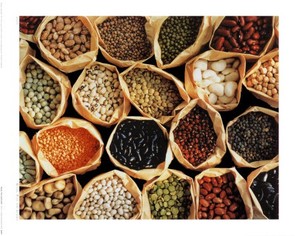 - Beans and vegetables like broccoli and kale give me indigestion. What can I do about this?Switching to a vegan diet can be challenging for the digestive system as you might be eating a lot more fiber. If you tough it out for 2 to 3 weeks and put up with a couple embarrassing elevator moments, your body should adjust.
Here are some things that you can do that will help make your transition easier.
- Chew your food more thoroughly. This allows the digestive enzymes in your mouth to take some of the burden off of the rest of your system.
- When cooking beans, always soak and rinse them thoroughly. This reduces their gas-causing oligosaccharides (sugars).
- Ginger and fennel are two great homeopathic ways to settle an unsettled gut. Try sipping ginger tea or chewing on fennel seeds.
- Two important factors in breaking down these foods are digestive enzymes and healthy gut bacteria. Enzyme supplements and probiotics are two great ways to help yourself out in this area.
- here can I find some vegan recipes to get me started? Becoming Vegan by Brenda Davis, R.D. and Vesanto Melina, M.S., R.D. This book covers every aspect of vegan nutrition, from the history of veganism to how vegans can get the macronutrients—protein, carbs, and fat—they need.
Veganomicon: The Ultimate Vegan Cookbook by Isa Chandra Moskowitz and Terry Hope Romero. This book takes less of a scientific approach and more of a culinary one. It's like The Joy of Cooking for vegans.
Finally, chef and author Mark Bittman has long been an advocate of reducing animal products in the American diet while maintaining the yum factor. Start exploring his amazing veggie recipes at his Web site.
- On second thought, I'm not ready to go fully vegan. What other options do I have? Several. There's ovo-lacto vegetarianism, which means you include eggs and dairy in your diet. There's pescatarianism, which means you keep a mostly vegetarian diet but eat fish—that's how I eat. Tony Horton is a flexitarian, meaning he mostly eats vegan, but does occasionally eat meat. Tony is especially picky about what animal products he eats. His poultry is organic and field-raised, his seafood is wild-caught and sustainable, and his beef is organic and free-range.
But you don't have to follow any specific dogma. If you want to cut down on animal products, do it as you see fit. Perhaps you can take part in the "Meatless Monday" campaign launched by the Johns Hopkins School of Public Health's Center for a Livable Future and not eat animal products on Mondays.
No matter what you do, cutting back on your meat intake is probably going to be good for you and for the planet. According to the United Nations' Food and Agriculture Organization, Americans are among the highest per capita meat gobblers on Earth—and we're no healthier.
If you have any additional questions for Denis or the rest of the Beachbody Advice Staff, you can reach them on the Team Beachbody Message Boards. They're always happy to help!
By Rebecca Swanner
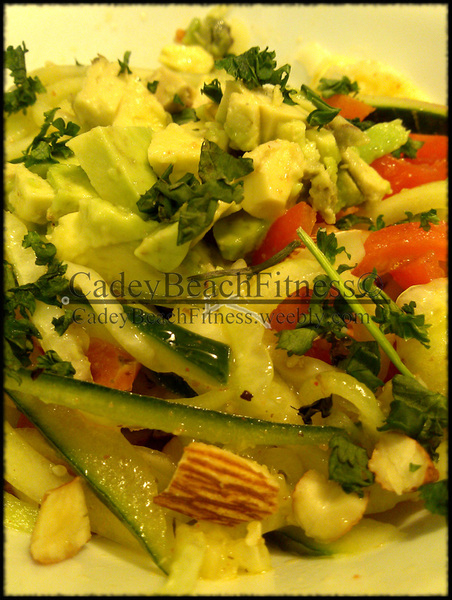 I love the way I feel since switching to a vegan diet. It's not for everyone , but for me it works. The only issue I find is finding enough of a variety in what I cook.
Now don't get me wrong I eat a lot of different food, but preparing them I tend to get in a rut. Right now we are also mid transit to Bahrain! So my cooking techniques are very limited. I have a couple knives, a electric counter top burner, cutting board, a couple pans, basically a full size fridge.
It is actually a very nice set up considering. So staying healthy while in hotels IS possible. it just takes some planning.
Cucumber Tomato Salad 1 medium cucumber
5-8 cherry tomatoes
1 tbsp onion
2tbsp cilantro/parsley
1/4 avocado Dressing 1 tbsp cold pressed olive oil-extra virgin
2tbsp apple cider vinegar
salt free herb seasoning to taste Directions- Cut cucumber in spaghetti strips. ( you can cut cucumber in any way you wish, I choose strips to add a little change up).
Next dice the onion and tomato and add to bowl.
chop up almonds and add to bowl.
mince up fresh parsley and cilantro and add.
score half of the avocado and scoop out 1/4.
Mix the dressing ingredients and add to chopped ingredients. Nutritional breakdown
|

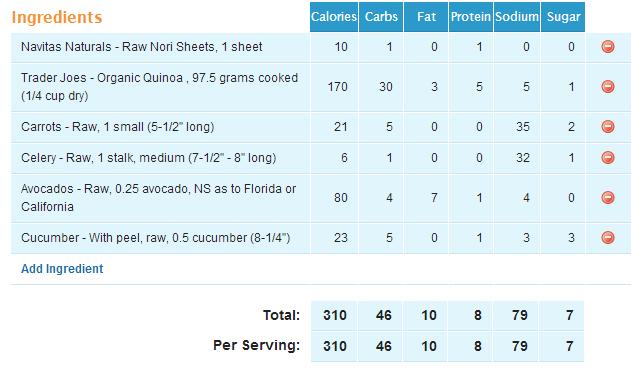







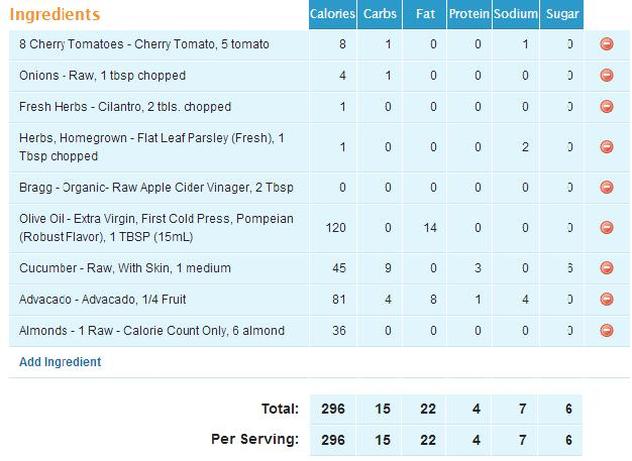
 RSS Feed
RSS Feed